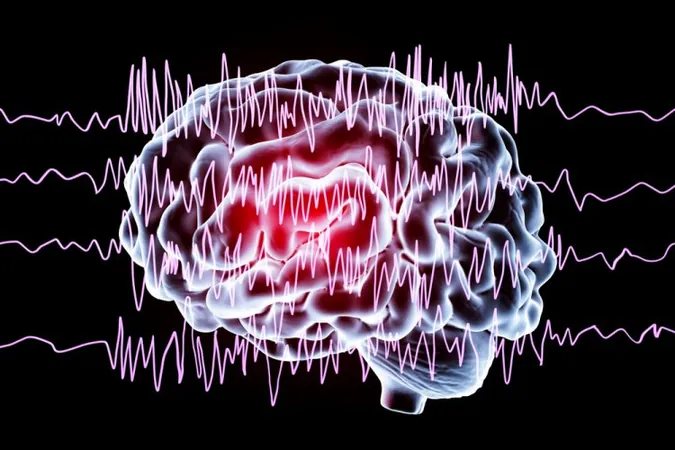
Revolutionary Advances in Deep Brain Stimulation Offer Hope for Epilepsy Patients
2025-09-17
Author: Siti
Breakthrough Study Enhances Seizure Control for Drug-Resistant Epilepsy
A groundbreaking study sheds light on the potential of deep brain stimulation (DBS) aimed at the centromedian nucleus (CM), providing a renewed lifeline for patients battling drug-resistant epilepsy. With approximately one-third of the 50 million epilepsy sufferers globally unable to find relief through conventional anti-seizure medications, this research opens doors in an area often seen as a dead end.
For these individuals, surgical options are limited, especially as seizures can originate from multiple brain regions, complicating surgical interventions.
Innovative Approaches to Deep Brain Stimulation
The review from University Hospital La Princesa, in partnership with Johannes Gutenberg University Mainz, showcases advanced strategies to enhance CM targeting during DBS. This treatment involves implanting a device that delivers electrical impulses directly to the brain, offering hope of partial seizure control for those not eligible for surgery.
How Does Deep Brain Stimulation Work?
In DBS, electrical stimuli are directed to specific brain regions using precisely placed electrodes. While targeting the anterior nucleus of the thalamus has received approval for epilepsy in regions like Europe and Canada, the focus is now shifting towards the centromedian nucleus (CM). Due to its intricate connections, stimulating the CM could potentially help manage frontal lobe seizures and those associated with conditions like Lennox-Gastaut syndrome.
Challenges in Targeting the Centromedian Nucleus
However, targeting the CM is fraught with difficulties. Its small size and deep location near other thalamic nuclei make it challenging to identify using traditional imaging techniques, resulting in a risk of improper electrode placement and disappointing surgical results.
Transformative Techniques for Improved Targeting
Dr. Torres Díaz, the study's lead author, emphasizes the need to minimize targeting errors: "By integrating advanced imaging and neurophysiological methods, we can confidently locate the CM, particularly in patients with unique anatomical characteristics."
The review discusses cutting-edge high-resolution MRI techniques, like magnetisation-prepared 2 rapid acquisition gradient echo (MP2RAGE), which enhance the distinction between the CM and surrounding structures, leading to more accurate anatomical identification.
Other promising techniques, such as quantitative susceptibility mapping (QSM) and the edge-enhancing gradient echo (EDGE-MICRA), aim to refine CM delineation.
Intraoperative Innovations Revolutionizing DBS
One revolutionary method, intraoperative microelectrode recordings (MER), allows surgeons to monitor electrical activity from brain structures, differentiating adjacent tissues based on their neural firing patterns. Remarkably, the CM displays unique 'tonic activity' that helps guide electrode placement during surgeries.
Identifying Critical Neural Pathways
Diffusion tensor imaging (DTI) tractography takes targeting a step further by mapping essential brain circuits, ensuring stimulation directly addresses specific pathways. Clinical findings reveal that patients whose electrodes align with optimally identified pathways have seen significant reductions in seizure frequency.
"Our findings indicate that successful responses to CM-DBS are closely linked to specific brain networks involved in motor function and arousal," Dr. Torres Díaz explained, underscoring that precise targeting involves understanding not just the CM itself, but the broader circuits it influences.
Path Towards Personalized Treatments
The review provides a detailed blueprint for effectively implementing CM-DBS in patients with resistant epilepsy. By fusing imaging techniques, electrophysiological mapping, and connectivity analysis, surgical teams can now achieve better electrode placement while accommodating individual brain structures and seizure networks.
Dr. Torres Díaz optimistically concludes, "As our diagnostic technologies evolve, CM-DBS could yield life-changing outcomes for patients previously considered untreatable. Precision targeting goes beyond technical skill—it's about restoring hope for individuals grappling with the most complex forms of epilepsy."
 Brasil (PT)
Brasil (PT)
 Canada (EN)
Canada (EN)
 Chile (ES)
Chile (ES)
 Česko (CS)
Česko (CS)
 대한민국 (KO)
대한민국 (KO)
 España (ES)
España (ES)
 France (FR)
France (FR)
 Hong Kong (EN)
Hong Kong (EN)
 Italia (IT)
Italia (IT)
 日本 (JA)
日本 (JA)
 Magyarország (HU)
Magyarország (HU)
 Norge (NO)
Norge (NO)
 Polska (PL)
Polska (PL)
 Schweiz (DE)
Schweiz (DE)
 Singapore (EN)
Singapore (EN)
 Sverige (SV)
Sverige (SV)
 Suomi (FI)
Suomi (FI)
 Türkiye (TR)
Türkiye (TR)
 الإمارات العربية المتحدة (AR)
الإمارات العربية المتحدة (AR)